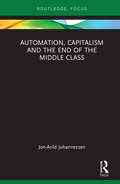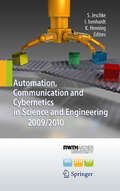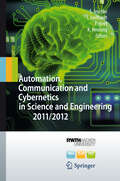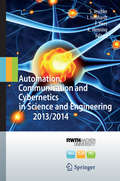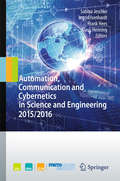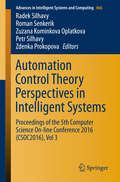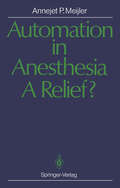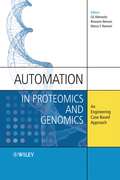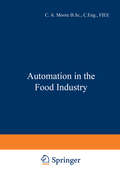- Table View
- List View
Automation, Capitalism and the End of the Middle Class (Routledge Focus on Economics and Finance)
by Jon-Arild JohannessenIn this book, the author argues that a new form of capitalism is emerging at the threshold of the Fourth Industrial Revolution. He asserts that we are in the midst of a transition from democratic capitalism to feudal capitalism and highlights how robotization and innovation is leading to a social crisis for the middle classes as economic inequality is on the rise. Johannessen outlines the three elements – Balkanization, the Great Illusion, and the plutocracy – which are referred to here as feudal structures. He describes, analyzes, and discusses these elements both individually and in interaction with each other, and asks: "What structures and processes are promoting and boosting feudal capitalism?" Additionally, the book serves to generate knowledge about how the middle class will develop in the Fourth Industrial Revolution. It shows the various effects of robotization on the middle class, where middle class jobs are transformed, deconstructed, and re-constructed and new part-time jobs are created for the middle class. Given the interest in the Fourth Industrial Revolution, the book will appeal to students of economic sociology and political economy as well as those in innovation and knowledge management courses focusing upon the emerging innovation economy. The topic will attract policymakers, and the accessible and engaging tone will also make the book of interest to the general public.
Automation, Capitalism and the End of the Middle Class (Routledge Focus on Economics and Finance)
by Jon-Arild JohannessenIn this book, the author argues that a new form of capitalism is emerging at the threshold of the Fourth Industrial Revolution. He asserts that we are in the midst of a transition from democratic capitalism to feudal capitalism and highlights how robotization and innovation is leading to a social crisis for the middle classes as economic inequality is on the rise. Johannessen outlines the three elements – Balkanization, the Great Illusion, and the plutocracy – which are referred to here as feudal structures. He describes, analyzes, and discusses these elements both individually and in interaction with each other, and asks: "What structures and processes are promoting and boosting feudal capitalism?" Additionally, the book serves to generate knowledge about how the middle class will develop in the Fourth Industrial Revolution. It shows the various effects of robotization on the middle class, where middle class jobs are transformed, deconstructed, and re-constructed and new part-time jobs are created for the middle class. Given the interest in the Fourth Industrial Revolution, the book will appeal to students of economic sociology and political economy as well as those in innovation and knowledge management courses focusing upon the emerging innovation economy. The topic will attract policymakers, and the accessible and engaging tone will also make the book of interest to the general public.
Automation Challenges of Socio-technical Systems: Paradoxes and Conflicts
by Frédéric Vanderhaegen Choubeila Maaoui Mohamed Sallak Denis BerdjagThe challenges of automating socio-technical systems are strongly linked to the strengths and limitations of technical and human resources, such as perceptual characteristics, cooperative capacities, job-sharing arrangements, modeling of human behavior and the contribution of innovative design approaches. Automation Challenges of Socio-technical Systems exposes the difficulties in implementing and sustaining symbiosis between humans and machines in both the short and long terms. Furthermore, it presents innovative solutions for achieving such symbiosis, drawing on skills from cognitive sciences, engineering sciences and the social sciences. It is aimed at researchers, academics and engineers in these fields.
Automation Challenges of Socio-technical Systems: Paradoxes and Conflicts
by Freìdeìric Vanderhaegen Maaoui Maaoui Mohamed Sallak Denis Berdjag Choubeila MaaouiThe challenges of automating socio-technical systems are strongly linked to the strengths and limitations of technical and human resources, such as perceptual characteristics, cooperative capacities, job-sharing arrangements, modeling of human behavior and the contribution of innovative design approaches. Automation Challenges of Socio-technical Systems exposes the difficulties in implementing and sustaining symbiosis between humans and machines in both the short and long terms. Furthermore, it presents innovative solutions for achieving such symbiosis, drawing on skills from cognitive sciences, engineering sciences and the social sciences. It is aimed at researchers, academics and engineers in these fields.
Automation, Communication and Cybernetics in Science and Engineering 2009/2010
by Sabina Jeschke Ingrid Isenhardt Klaus HenningThe book presents a representative selection of all publications published between 01/2009 and 06/2010 in various books, journals and conference proceedings by the researchers of the institute cluster: IMA - Institute of Information Management in Mechanical Engineering ZLW - Center for Learning and Knowledge Management IfU - Institute for Management Cybernetics, Faculty of Mechanical Engineering, RWTH Aachen University The contributions address the cluster's five core research fields: suitable processes for knowledge- and technology-intensive organizations, next-generation teaching and learning concepts for universities and the economy, cognitive IT-supported processes for heterogeneous and cooperative systems, target group-adapted user models for innovation and technology development processes, semantic networks and ontologies for complex value chains and virtual environments Innovative fields of application such as cognitive systems, autonomous truck convoys, telemedicine, ontology engineering, knowledge and information management, learning models and technologies, organizational development and management cybernetics are presented. The contributions show the unique potential of the broad and interdisciplinary research approach of the ZLW/IMA and the IfU.
Automation, Communication and Cybernetics in Science and Engineering 2011/2012
by Sabina Jeschke Ingrid Isenhardt Frank Hees Klaus HenningThe book is the follow-up to its predecessor “Automation, Communication and Cybernetics in Science and Engineering 2009/2010” and includes a representative selection of all scientific publications published between 07/2011 and 06/2012 in various books, journals and conference proceedings by the researchers of the following institute cluster:IMA - Institute of Information Management in Mechanical EngineeringZLW - Center for Learning and Knowledge ManagementIfU - Associated Institute for Management CyberneticsFaculty of Mechanical Engineering, RWTH Aachen UniversityInnovative fields of application, such as cognitive systems, autonomous truck convoys, telemedicine, ontology engineering, knowledge and information management, learning models and technologies, organizational development and management cybernetics are presented.
Automation, Communication and Cybernetics in Science and Engineering 2013/2014
by Sabina Jeschke Ingrid Isenhardt Frank Hees Klaus HenningThis book continues the tradition of its predecessors “Automation, Communication and Cybernetics in Science and Engineering 2009/2010 and 2011/2012” and includes a representative selection of scientific publications from researchers at the institute cluster IMA/ZLW & IfU. IMA - Institute of Information Management in Mechanical Engineering ZLW - Center for Learning and Knowledge Management IfU - Associated Institute for Management Cybernetics e.V. Faculty of Mechanical Engineering, RWTH Aachen University The book presents a range of innovative fields of application, including: cognitive systems, cyber-physical production systems, robotics, automation technology, machine learning, natural language processing, data mining, predictive data analytics, visual analytics, innovation and diversity management, demographic models, virtual and remote laboratories, virtual and augmented realities, multimedia learning environments, organizational development and management cybernetics. The contributions selected reflect the fundamental paradigm shift toward an increasingly interdisciplinary research world – which has always been both the basis and spirit of the institute cluster IMA/ZLW & IfU.
Automation, Communication and Cybernetics in Science and Engineering 2015/2016
by Sabina Jeschke Ingrid Isenhardt Frank Hees Klaus HenningAutomation, Communication and Cybernetics in Science and Engineering
Automation Control Theory Perspectives in Intelligent Systems: Proceedings of the 5th Computer Science On-line Conference 2016 (CSOC2016), Vol 3 (Advances in Intelligent Systems and Computing #466)
by Radek Silhavy Roman Senkerik Zuzana Kominkova Oplatkova Petr Silhavy Zdenka ProkopovaThe volume Automation Control Theory Perspectives in Intelligent Systems presents new approaches and methods to real-world problems, and in particular, exploratory research that describes novel approaches in the field of cybernetics and automation control theory. Particular emphasis is laid on modern trends in intelligent information technology, system monitoring and proactive management of complex objects The 5th Computer Science On-line Conference (CSOC2016) is intended to provide an international forum for discussions on the latest high-quality research results in all areas related to Computer Science. The addressed topics are the theoretical aspects and applications of Computer Science, Artificial Intelligences, Cybernetics, Automation Control Theory and Software Engineering.
Automation for Robotics
by Luc JaulinIn order to enable a better understanding of the key concepts of automation, this book develops the fundamental aspects of the field while also proposing numerous concrete exercises and their solutions. The theoretical approach that it presents fundamentally uses the state space and makes it possible to process general and complex systems in a simple way, involving several switches and sensors of different types. This approach requires the use of developed theoretical tools such as linear algebra, analysis and physics, generally taught in preparatory classes for specialist engineering courses.
Automation for Robotics
by Luc JaulinIn order to enable a better understanding of the key concepts of automation, this book develops the fundamental aspects of the field while also proposing numerous concrete exercises and their solutions. The theoretical approach that it presents fundamentally uses the state space and makes it possible to process general and complex systems in a simple way, involving several switches and sensors of different types. This approach requires the use of developed theoretical tools such as linear algebra, analysis and physics, generally taught in preparatory classes for specialist engineering courses.
Automation im Geldverkehr: Wirtschaftliche und soziale Auswirkungen (Sozialverträgliche Technikgestaltung, Hauptreihe)
by Gerhard Weiß Peter GeorgieffUm Erkenntnisse über Verlauf und Richtung der Automatisierungsprozesse zu gewinnen und um die Voraussetzungen für eine Gestaltung dieser Prozesse verbessern zu können, wurden die technischen Entwicklungslinien sowie die sozialen und ökonomischen Auswirkungen auf die Organisation, auf Arbeitsplätze und private Haushalte untersucht sowie Möglichkeiten zur sozialverträglichen Technikgestaltung durch die Kreditinstitute als Anwender und für die betroffenen Beschäftigten erarbeitet.Für eine sozialverträgliche Technikgestaltung ist es erforderlich, das Problembewußtsein über die betrieblichen und sozialen Risiken des Verzichts auf soziale Innovationen bei den künftigen Automatisierungsprozessen des Zahlungsverkehrs zu entwickeln und einen Verständigungsprozeß zwischen den unterschiedlichen Beteiligten einzuleiten, der zu gemeinsamen Initiativen für soziale Innovationen führt.
Automation in Anesthesia — A Relief?: A Systematic Approach to Computers in Patient Monitoring
by Annejet P. MeijlerDescribes a Data Acquisition and Display System (DADS) for patient monitoring during anesthesia. It combines flexible data presentation on two color screens with a new alarm me- chanism and automated record keeping.
Automation in Automotive Industries: Recent Developments
by Anna Comacchio Guiseppe Volpato Arnaldo CamuffoG. Volpato, A. Camuffo, A. Comacchio 1.1 The background During recent years the dynamics of automotive industry and its supply chain has catalysed the attention and the research effort of a wide international group of scholars as: the International Motor Vehicle Program (JMVP) of Massachusetts Institute of Technology, the Permanent Study Group for the Automobile Industry and Its Employees (GERPISA) of Paris, and the International Car Distribution l Programme (ICDP) of Solihull. This favoured the publication of relevant studies and the growth of networks of academicians and practitioners interested in studying the patterns of industry evolution and in organising meetings to present and discuss issues of common interest. In 1992 some members of these research projects decided to organize a first conference in Berlin dedicated to the main theme of automation and organization in the automobile industry. In 1993 a second conference took place in Tokyo, followed by a technical visit to a few automobile manufacturers and components suppliers plants (Toyota, Nissan, Mitsubishi, etc.).
Automation in blood transfusion: Proceedings of the Thirteenth International Symposium on Blood Transfusion, Groningen 1988, organized by the Red Cross Blood Bank Groningen-Drenthe (Developments in Hematology and Immunology #22)
by C. Th. Smit SibingaWith this symposium the Red Cross Blood Bank Groningen-Drenthe affirms its well known reputation as an organizer of symposia of high standard and quality. Several important aspects of bloodbanking have been discussed in the past. The Blood Bank here is a specialist in its own field. Administrative processes in respect of the donor, information processes, the preparation of the blood and the laboratory process are automatized. New developments in these fields are undeway that you will certainly identify and investigate. I do hope that you will come to conclusions from which we can learn and get better results. As general manager of the Development and Investments Company for the Northern Netherlands - NOM - for several reasons I am very much interested in the outcome of this symposium. In the first place I am proud that the Red Cross Blood Bank Groningen Drenthe is doing its utmost to be excellent in regard of research, education and bloodprocessing. In being so, the Blood Bank can produce spinn-offs for healthservices and the related industry.
Automation in Communication: The Ideological Implications of Language Machines (Routledge Studies in Sociolinguistics)
by Lionel WeeBy drawing on multiple examples from healthcare, religion, service encounters and poetry, Lionel Wee presents rich insights into the use of automation in communication through a posthumanist lens. As communication becomes increasingly automated, the use of automation creates significant conceptual challenges for ideologies about language, beliefs about the nature of language, as well as assumptions about the roles that interpretation, anthropomorphism, and folk theories of mind play when language is used in communication. This book unravels the ideological implications of automation in communication and provides a new theoretical ground to address the major issues raised by automation. Wee discusses the importance of thinking carefully about how we identify and distinguish the roles of speaker and hearer. He also argues that we re-evaluate our understanding of the relationship between language and community.This book will be vital to students interested in studying the intersections of AI, language and communication, as well as researchers working in communication studies, linguistics and the broader sociology of language in the age of technological change.
Automation in Communication: The Ideological Implications of Language Machines (Routledge Studies in Sociolinguistics)
by Lionel WeeBy drawing on multiple examples from healthcare, religion, service encounters and poetry, Lionel Wee presents rich insights into the use of automation in communication through a posthumanist lens. As communication becomes increasingly automated, the use of automation creates significant conceptual challenges for ideologies about language, beliefs about the nature of language, as well as assumptions about the roles that interpretation, anthropomorphism, and folk theories of mind play when language is used in communication. This book unravels the ideological implications of automation in communication and provides a new theoretical ground to address the major issues raised by automation. Wee discusses the importance of thinking carefully about how we identify and distinguish the roles of speaker and hearer. He also argues that we re-evaluate our understanding of the relationship between language and community.This book will be vital to students interested in studying the intersections of AI, language and communication, as well as researchers working in communication studies, linguistics and the broader sociology of language in the age of technological change.
Automation in Construction toward Resilience: Robotics, Smart Materials and Intelligent Systems (Resilience and Sustainability in Civil, Mechanical, Aerospace and Manufacturing Engineering Systems)
by Ehsan Noroozinejad Farsangi Mohammad Noori Yang, Tony T.Y. Paulo B. Lourenço Paolo Gardoni Izuru Takewaki Eleni Chatzi Shaofan LiWhile the word "automation" may conjure images of robots taking over jobs, the reality is much more nuanced. In construction, for instance, automation is less likely to diminish employment opportunities than it is to increase productivity. Indeed, automation alongside the global need for new and updated infrastructure and better and more affordable housing can help shape the direction of the construction industry. The key will be anticipating and preparing for the shift, in part by developing new skills in the current and future workforce. This book presents all aspects of automation in construction pertaining to the use of information technologies in design, engineering, construction technologies, and maintenance and management of constructed facilities. The broad scope encompasses all stages of the construction life cycle from initial planning and design, through the construction of the facility, its operation, and maintenance, to the eventual dismantling and recycling of buildings and engineering structures. Features: Examines Building Information Management systems, allowing on-site execution of construction more efficient, and for project teams to eliminate mistakes and better coordinate the workforce Presents the latest information on the automation of modular construction, production in factories, including 3-D printing of components such as facades, or even load-bearing and essential components
Automation in Construction toward Resilience: Robotics, Smart Materials and Intelligent Systems (Resilience and Sustainability in Civil, Mechanical, Aerospace and Manufacturing Engineering Systems)
While the word "automation" may conjure images of robots taking over jobs, the reality is much more nuanced. In construction, for instance, automation is less likely to diminish employment opportunities than it is to increase productivity. Indeed, automation alongside the global need for new and updated infrastructure and better and more affordable housing can help shape the direction of the construction industry. The key will be anticipating and preparing for the shift, in part by developing new skills in the current and future workforce. This book presents all aspects of automation in construction pertaining to the use of information technologies in design, engineering, construction technologies, and maintenance and management of constructed facilities. The broad scope encompasses all stages of the construction life cycle from initial planning and design, through the construction of the facility, its operation, and maintenance, to the eventual dismantling and recycling of buildings and engineering structures. Features: Examines Building Information Management systems, allowing on-site execution of construction more efficient, and for project teams to eliminate mistakes and better coordinate the workforce Presents the latest information on the automation of modular construction, production in factories, including 3-D printing of components such as facades, or even load-bearing and essential components
Automation in Proteomics and Genomics: An Engineering Case-Based Approach
by Gil Alterovitz Roseann M. Benson Marco RamoniIn the last decade DNA sequencing costs have decreased over a magnitude, largely because of increasing throughput by incremental advances in tools, technologies and process improvements. Further cost reductions in this and in related proteomics technologies are expected as a result of the development of new high-throughput techniques and the computational machinery needed to analyze data generated. Automation in Proteomics & Genomics: An Engineering Case-Based Approach describes the automation technology currently in the areas of analysis, design, and integration, as well as providing basic biology concepts behind proteomics and genomics. The book also discusses the current technological limitations that can be viewed as an emerging market rather than a research bottleneck. Topics covered include: molecular biology fundamentals: from ‘blueprint’ (DNA) to ‘task list’ (RNA) to ‘molecular machine’ (protein); proteomics methods and technologies; modelling protein networks and interactions analysis via automation: DNA sequencing; microarrays and other parallelization technologies; protein characterization and identification; protein interaction and gene regulatory networks design via automation: DNA synthesis; RNA by design; building protein libraries; synthetic networks integration: multiple modalities; computational and experimental methods; trends in automation for genomics and proteomics new enabling technologies and future applications Automation in Proteomics & Genomics: An Engineering Case-Based Approach is an essential guide to the current capabilities and challenges of high-throughput analysis of genes and proteins for bioinformaticians, engineers, chemists, and biologists interested in developing a cross-discipline problem-solving based approach to systems biology.
Automation in Textile Machinery: Instrumentation and Control System Design Principles
by L. Ashok Kumar M Senthil kumarAutomation is the use of various control systems for operating equipment such as machinery and processes. In line, this book deals with comprehensive analysis of the trends and technologies in automation and control systems used in textile engineering. The control systems descript in all chapters is to dissect the important components of an integrated control system in spinning, weaving, knitting, chemical processing and garment industries, and then to determine if and how the components are converging to provide manageable and reliable systems throughout the chain from fiber to the ultimate customer. Key Features: • Describes the design features of machinery for operating various textile machineries in product manufacturing • Covers the fundamentals of the instrumentation and control engineering used in textile machineries • Illustrates sensors and basic elements for textile automation • Highlights the need of robotics in textile engineering • Reviews the overall idea and scope of research in designing textile machineries
Automation in Textile Machinery: Instrumentation and Control System Design Principles
by L. Ashok Kumar M Senthil kumarAutomation is the use of various control systems for operating equipment such as machinery and processes. In line, this book deals with comprehensive analysis of the trends and technologies in automation and control systems used in textile engineering. The control systems descript in all chapters is to dissect the important components of an integrated control system in spinning, weaving, knitting, chemical processing and garment industries, and then to determine if and how the components are converging to provide manageable and reliable systems throughout the chain from fiber to the ultimate customer. Key Features: • Describes the design features of machinery for operating various textile machineries in product manufacturing • Covers the fundamentals of the instrumentation and control engineering used in textile machineries • Illustrates sensors and basic elements for textile automation • Highlights the need of robotics in textile engineering • Reviews the overall idea and scope of research in designing textile machineries
Automation in the Food Industry
by C. A. MooreThis book is designed to be everything its title suggests-a practical guide to automation within the food industry. It is the first book to offer practical advice on what can be a most bewildering subject in an industry where the use of effective automation is of paramount importance. There are many books dealing with the theory and practice of control systems in both the food and other industries. However, these tend to offer too much detail in both areas to be classed as overviews, or cover too much of the more obvious detail and gloss over, or avoid, the elements where the decisions are hard-even though these are the areas which are fundamental to successful and expansive projects. This book identifies those elements of any automation scheme which have to be considered first, and that form the foundations for any successful project. The editorial introduction outlines the content of the book and is a useful starting point. Examples are used, wherever possible, to show what can be done, how it can be achieved, and what to avoid. A glossary of definitions is included at the end of the book. All the chapters have been written by engineers, with many years' experience in this field, who have been able to express their views freely. The result is a book which covers the key areas of the subject, using a minimum of the technical jargon with which this subject abounds, in a readable, practical manner.
Automation in the Virtual Testing of Mechanical Systems: Theories and Implementation Techniques
by Ole Ivar Sivertsen Bjorn HaugenAutomation in the Virtual Testing of Mechanical Systems: Theories and Implementation Techniques provides a practical understanding of Knowledge-Based Engineering (KBE), an approach that is driving automation in engineering. Companies are using the technology to automate engineering tasks, achieving gains in output, and saving time. This book will be the main source of information available for implementing KBE systems, integrating KBE with the finite element methods, and showing how KBE is used to automate engineering and analysis of mechanical systems. The process of combining KBE with optimization techniques is explored, and the use of software tools is presented in some detail. Features Introduces automation with Knowledge-Based Engineering (KBE) in generic mechanical design Develops a framework for generic mechanism modeling including a library format Explores a KBE environment for generic design automation Includes design cases in KBE Gives a presentation of the interwoven technologies used in modern design environments
